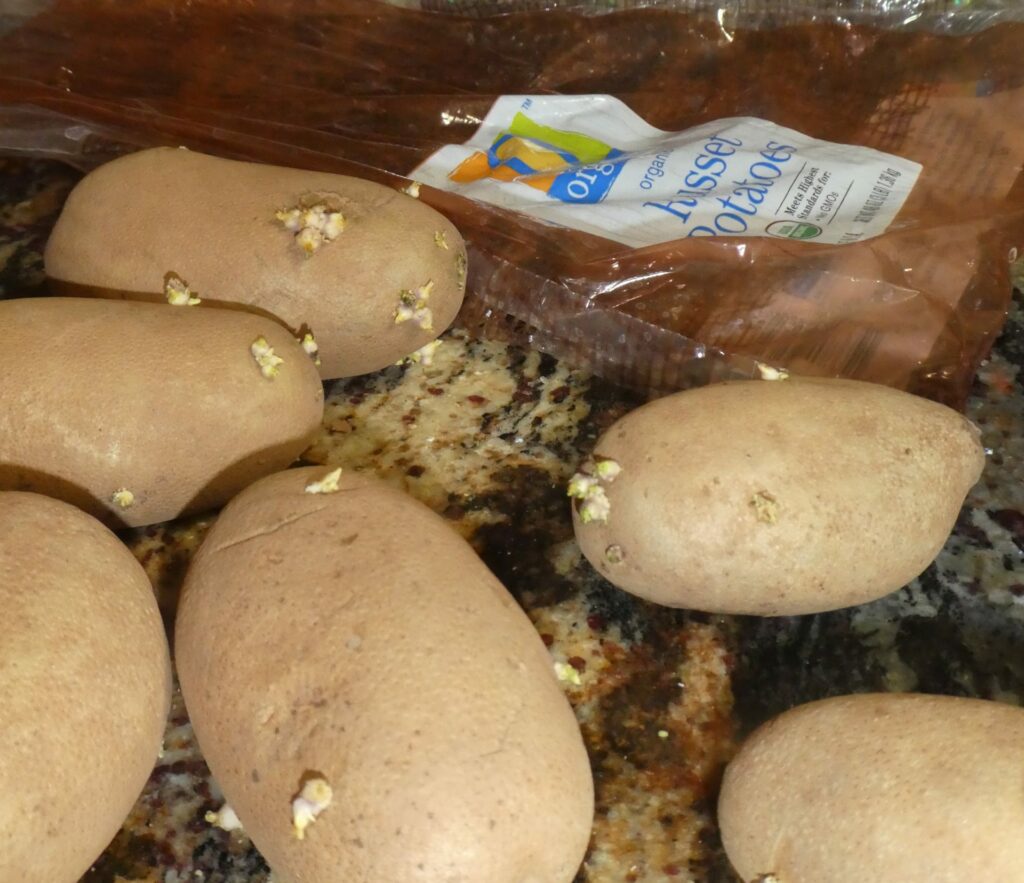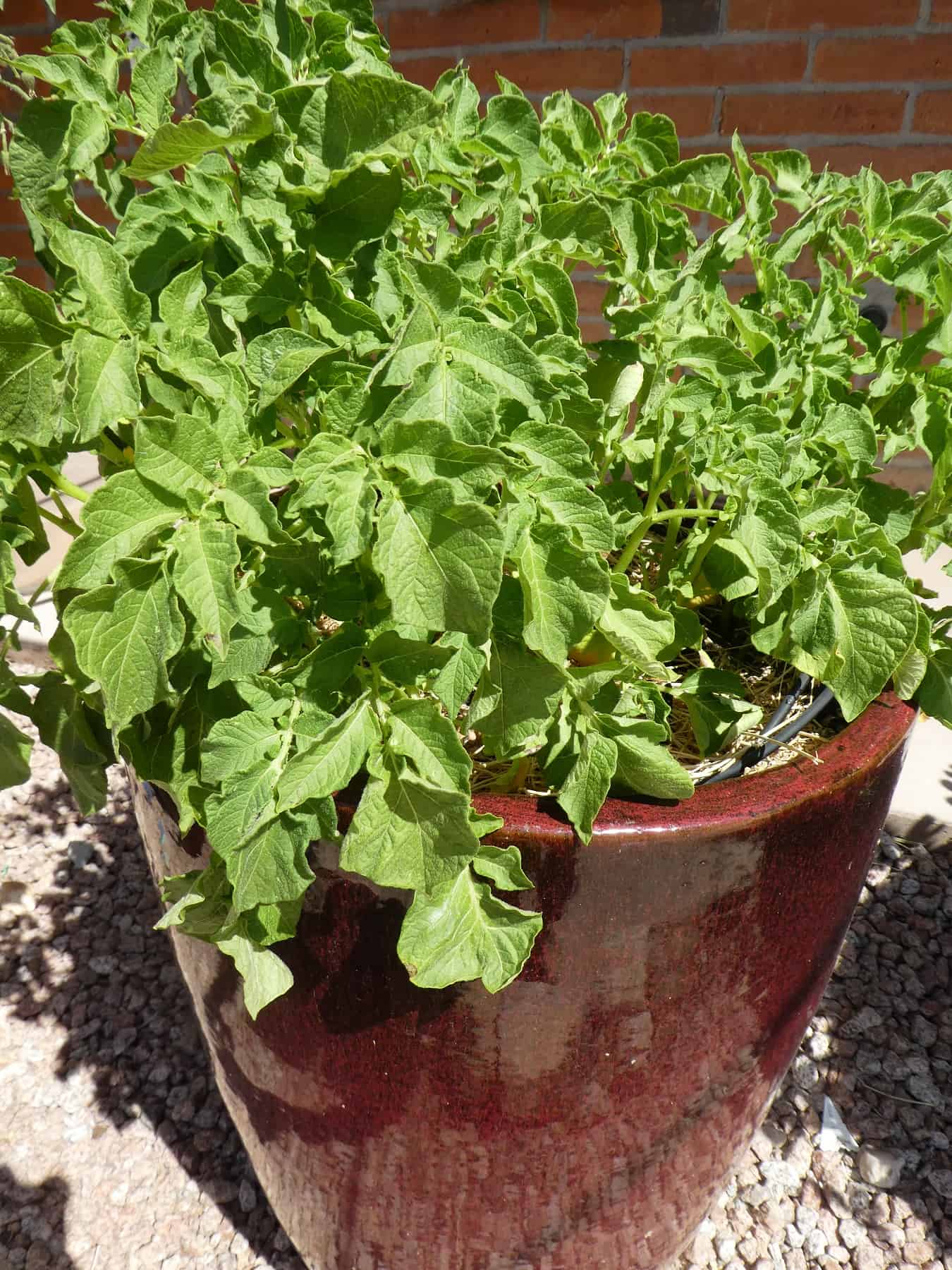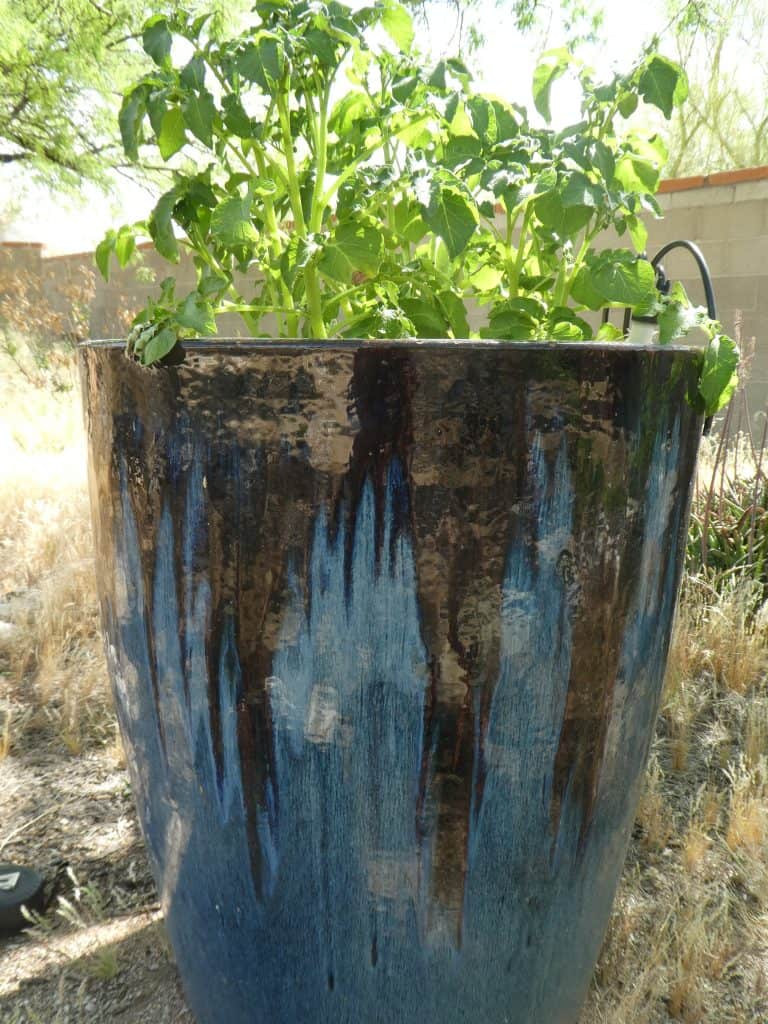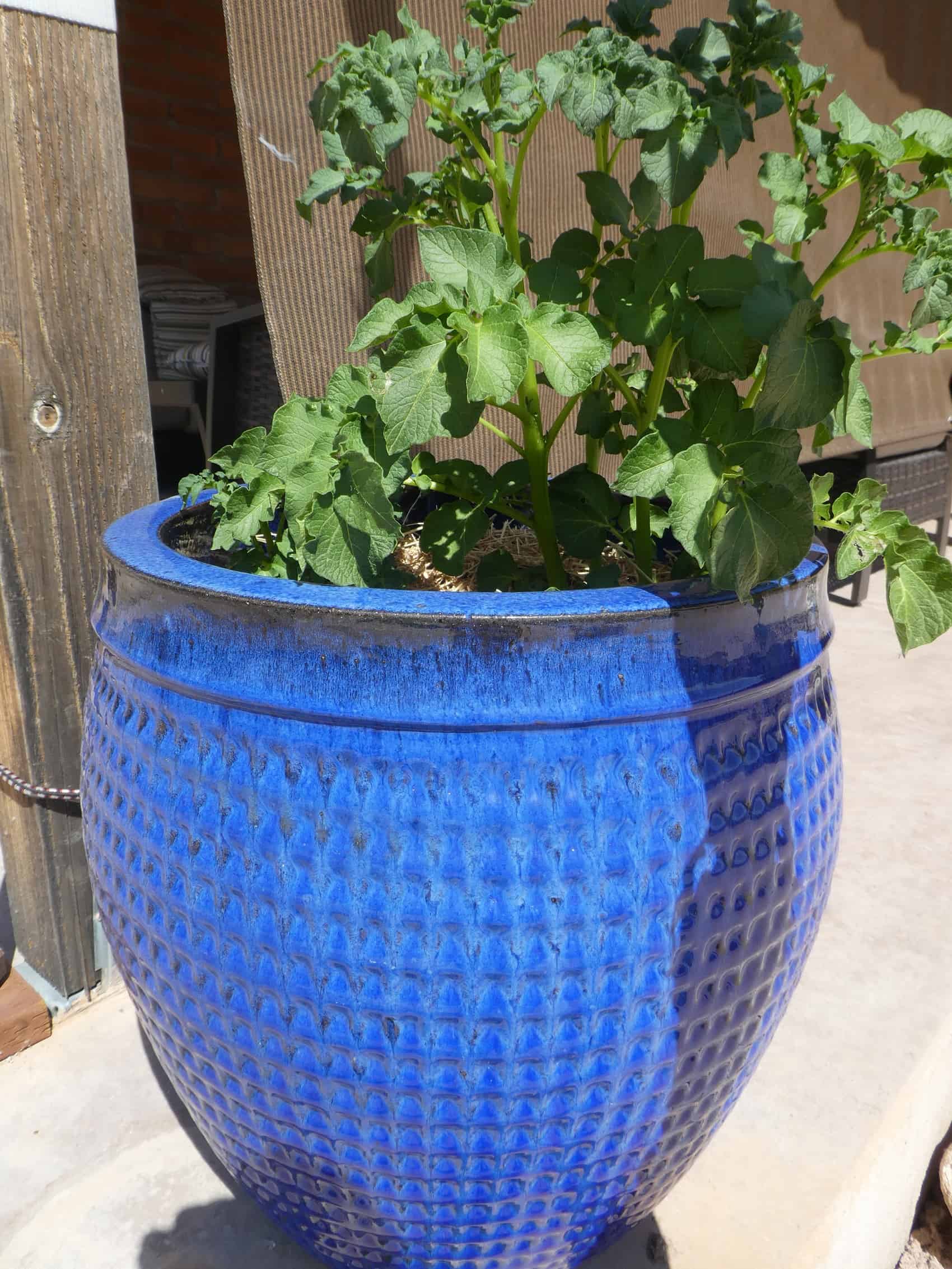Growing potatoes in containers is easy and convenient. Potatoes grow well in large pots and planters. If you have a deep enough planter, you can be successful at growing potatoes. There are many advantages to growing them in containers but it needs to be deep enough so you can hill the potatoes as they grow.
Growing potatoes make for a reliable food source. You can grow them across growing seasons and in many hardiness zones. In addition, planting potatoes in planters frees up your garden to grow other things. You can move them around to maximize sun exposure as well.
Planting Potatoes in Containers
If you already have planters on your property, the rest is easy. You will need quality soil and some potatoes. You can use store-bought potatoes that are sprouting, or you can buy certified seed potatoes from a garden center, nursery, or online.
Materials for growing potatoes
I discuss each of these below.
- Container, planter, pot
- Certified seed potatoes or store-bought potatoes
- Quality potting soil
How deep should a container be for potatoes?
When choosing a container, you need to be sure it’s deep enough. The pot or container should be at least 15″ deep for growing potatoes. The deeper the pot, the more you can usually grow because of hilling which I explain below. Be sure there are enough drainage holes on the bottom. You want to avoid rot.
I have been successful growing potatoes in 5-gallon buckets and love the convenience of them, but you are limited on space. With a larger container, you can usually harvest more tubers.
Types of containers
Most any food-safe container can work if it’s deep enough. You can plant in garbage cans, sacks, and garbage bags to grow potatoes. Most any container will work as long as you follow the steps for a successful crop. Tires also work well. You can stack tires on top of each other and add more soil as you hill the plants.

What potatoes to plant in a planter
The potatoes you plant are very important. You want to make sure you are successful growing them.
Store-bought potatoes
You can plant any store-bought potatoes that are sprouting. The downside to buying potatoes from the grocery store and waiting for them to sprout is that they are typically treated with sprout inhibitors.
When they are sprayed with sprout inhibitors, they will have a longer shelf life in the stores. This means, once you buy them and bring them home, they may never sprout. However, when you buy organic potatoes, you’ll have a better chance they will sprout as they likely won’t have been treated with a sprout inhibitor. Buy organic and leave them out on the kitchen counter. When they start sprouting, you can plant them.
Certified seed potatoes
The experts recommend to purchase seed potatoes if you want to grow potatoes at home. These are actual potatoes you purchase. They are specifically grown and sold to be replanted. If you want to purchase seed potatoes, be sure to buy certified seed potatoes. They won’t have been treated with a sprout inhibitor. You can find organic, non-GMO certified seed potatoes in local nurseries and garden centers as well as online from seed companies.
When you plant seed potatoes in a container, you don’t have to wait for them to sprout before planting them. Sprouts from seed potatoes will start emerging after two weeks until about 28 days.
Good potting soil
Buy some good quality garden soil for container gardening. It should be a well-draining soil mixture. There are many on the market that include compost. Otherwise, amend the soil by adding in compost from your pile. In addition, add organic fertilizer. Some garden experts recommend adding bone meal to their potatoes in containers and pots; however, we have never done this.
A huge advantage to growing potatoes in containers is it doesn’t matter if you have poor soil on your property. You can buy quality soil which will help grow potatoes.
When to plant tubers in containers
Plant them after the last frost. This is late March – mid April in many areas throughout North America. Knowing your hardiness zone, which is based on the annual average extreme minimum temperature, you can determine the last frost date.
In the spring, after the last frost, you can plant any potato variety. Soil temperature should be at least 40 degrees F (4.4 degrees C). See below to learn about the difference between potatoes based on their season.
There are some potato varieties you can plant in the middle of summer (mid season potatoes) and others you should plant in late summer into fall (late season potatoes). Again, in the spring, you can typically plant most all potato varieties.
Planting potatoes in containers
Now for the planting! It’s important to know how deep to plant potatoes in planters.
For containers without soil in them:
Fill the bottom with 4 – 5 inches of potting soil (10 – 12 cm). It doesn’t have to be exact. The potatoes grow upward, so you want to have as much room above as possible.
For containers with soil in them already:
Consider what type of soil was in the planter. You may want to replace some or all of it with new soil with compost. Even if you don’t remove all of the soil, you will want to incorporate good quality, well-draining potting soil.
In a container with existing soil, plant the potatoes so there are 4 – 5 inches of soil from the bottom. You can dig down with a trowel or shovel to place the potatoes or do it by hand.
Certified seed potatoes in planters:
If you are planting certified seed potatoes, you can either:
- Plant entire potato before it sprouts
- Plant entire potato that’s already sprouting with sprout side up
- Cut potato into chunks before it sprouts; each piece should have at least two eyes
Planting potatoes from the grocery store:
If you are planting potatoes from the grocery store, you must wait for them to sprout. Otherwise, you may end up planting potatoes that will never grow more potatoes.
Again, this is because they may have been treated with sprout inhibitors. Buy organic which will be more likely to sprout. Then you can either:
- Plant the entire potato with the sprout side up.
- Cut the potato into chunks, with a minimum of two eyes per piece. Plant sprout side up.
It’s your choice whether to plant the entire potato or cut it into pieces. If you have a deep container or pot, then you may want to plant it whole. We just plant the entire potato when we plant them in planters.

How many potatoes to plant in container
How many potatoes to plant in a container depends on how wide it is.
Also note if it’s much wider at the top and then narrower toward the bottom and middle. Use your judgement — give them enough space. For reference, we plant two potatoes in a 5 gallon bucket which just under 12″ in diameter (30.48 cm).
In our much-larger planters, we plant at least three or four. Examples:
- 12″ in diameter = 2 potatoes
- 14 – 18″ wide = 3 potatoes
- 20″ wide = 4 potatoes
Filling potato planter with soil
After you have set your potatoes in the soil, you will need to cover them with a minimum of 5 – 6 inches of soil. It’s important to leave room to add more soil as the plants grow. The reason for this is the potato plants grow taller, you will cover them with additional soil. This is called hilling.
How much to water potatoes in containers
You want to keep them moist but not wet. It’s important to not let the potatoes rot from too much water. However, potatoes growing in pots and planters will be retain heat and be hotter than if you planted them in a garden bed or in the ground. We sometimes use a basic moisture meter to ensure we aren’t over-watering or after heavy rains.
You can use a simple finger method as well. Every few days, stick your finger about 2″ in the soil to see if it’s moist. Unlike when we grow potatoes in buckets, our planters are larger — several feet tall — and we don’t see the water coming out the bottom. If you use smaller planters, you should be able to tell if water comes out the bottom.
Sunlight
When plants produce food, they need direct sunlight daily. Be sure position your planters so they receive 6 – 8 hours of sun per day. If you already have large, heavy planters on your property, plant potatoes in the ones that will be in the sun 6 – 8 hours.

Once you have your potatoes planted, and you see the potato plants coming out of the soil, be sure to leave them alone. Do not help them break through the soil. It’s important they do this on their own. This makes them stronger.
Leave room at the top of the planter to hill potatoes
Remember, when you are planting potatoes in planters, don’t fill the soil all the way to the top. You will need room to add more soil as the potato plants grow. As the potato plants grow taller, you will add dirt to “hill” them. By doing this, you will be able to grow more potatoes.
Hilling potatoes in planters
When your potato plants are about 6 – 7 inches tall, (approximately 16 cm) you will want to add more soil to the planter. Being careful not to break any of the stems, add more soil and compost, covering some of the leaves and stems.
Cover approximately one third of the plants. As your potato plants get taller, repeat this process until the soil reaches the top of the planter. You want to leave enough room so you can water without loosing dirt.
Harvesting
How do you know when to harvest potatoes? Your potatoes are ready to harvest when:
Potatoes flowering
You will know it’s harvest time when the potato plants flower. The potatoes are ready to eat but will continue to grow larger if you leave them after the potato plants flower. If you pick them now, they are still immature. At this stage they are called new potatoes, creamers or baby potatoes.
Potato plants yellow and brown leaves
When growing potatoes in a pot, it’s best to wait until the tubers mature fully before harvesting them. When the leaves turn yellow and brown, and the plants begin to wilt and droop, the potatoes are finished growing. This is the ideal time to harvest the potatoes.
Harvesting potatoes – the treasure hunt!
It’s like digging for buried treasure! If you have children or grandchildren, they will enjoy this process. It’s fun for adults too! Simply use your hands to gently pick the spuds. You don’t need special tools.
Curing homegrown potatoes
We eat our tubers within a week or so, but if you plan to store the potatoes long term, it’s best to cure them first. To cure potatoes, set them on newspaper in a dark, well-ventilated area for two weeks. The temperature should be between 45 – 60 degrees in an area with high humidity.
After this, you can store your potatoes for 4 – 6 months. Because we are growing potatoes in planters — we get about 10 – 12 per pot — we are excited to eat them right away. Therefore, we do not cure them.

It’s a wonderful feeling to be able to grow your own food. Growing potatoes in pots and planters is an easy way to do this without needing garden space.
Advantages to growing potatoes in pots
Less space
You don’t need a lot of space, making it ideal for balconies, decks, entryways.
Less insects
You will have less chance for insects by planting them in planters than if you planted potatoes in the ground.
Less pests
In addition, you won’t have to worry about rodents and other animals getting into your potatoes.
Less weeds
You will likely have less weeds in a planter than in a garden or garden bed.
Easy to harvest the potatoes
You will be sure to harvest all the potatoes and won’t have to bend down as far if you planted them in the ground.
Free up garden space
Growing potatoes in planters means you can plant other vegetables, herbs, flowers, etc. in your garden.
Fun to grow with kids
Kids will love planting potatoes, watering them, watching as they grow taller, and finally, harvesting them!
What are the best potatoes for planting in planters?
Potatoes are cool season vegetables. There are hundreds of varieties and many types of potatoes that will grow. They can tolerate a mild frost in early spring. You can be successful growing most any sprouting potato when you plant during the right season… spring in most areas.
If you are interested in finding out which potatoes will grow best in your area, it’s important to consider the season in which you will be planting them. This will take more time and effort because you likely won’t be using grocery store potatoes.
You should consider buying seed potatoes from a nursery who can instruct you on what will be best for your season and climate. This is because it helps to know if the potatoes are early season, medium season, or late season. They are categorized by when to plant them and how long they take to mature.
Early season potatoes
Mature within 75 – 90 days Yukon gold is one example, and you can easily find them in the supermarket.
Mid-season potatoes
These potatoes mature between 95 – 110 days. You can plant these toward the middle of your summer. In the United States, this is considered to be the end of July.
Late season potatoes
You should plant late season potatoes in the late summer into autumn. These potato varieties mature in 120 – 135 days. Knowing what potatoes to plant will help you be successful growing potatoes in planters.

How to grow potatoes in a pot
Container potatoes and planter potatoes are fun and easy to grow. They are low maintenance. Once you have the container, potatoes, and soil, you are ready to start.
Large planters and pots make great potato growing containers. They don’t take up a lot of space, and you will find it easy to grow your own food. Once you find a good container for potatoes, you can continue to reuse it. Add new soil and try sweet potatoes or other potato varieties.
Planters surround patios, balconies, decks, entryways, and gardens. People think of them for flowers, native plants, tomato plants, and herbs.
However, we love planting potatoes in pots because they are low maintenance, grow quickly and require little upkeep. Potatoes in containers frees up garden space for vining plants and other easy to grow vegetables.
There’s nothing like homegrown potatoes!
See also: Growing Tomatoes in Pots and Containers

